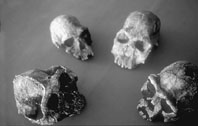

 | Page 969 |  |
and archaeologists have been able to trace the development of that industry through three phases (A, B, and C) on the site, and there is clear evidence of the replacement of these industries by the Acheulean around 1.4 million years ago.

Skulls discovered in Olduvai Gorge
(Gamma)
Work continued in the Olduvai Gorge after the death of Louis Leakey and the retirement of Mary Leakey from a leadership role at the site. Apart from being one of the world’s most significant localities for homind fossils, it is also one of the most important training grounds for the current leaders in paleoanthropology and Pleistocene archaeology.
See also
Africa, East, Prehistory; Laetoli
References
Leakey, L. S. B., et al. 1965–1996. Olduvai Gorge. Cambridge: Cambridge University Press.
Sept, J. M. 1997. Investigating Olduvai: Archaeology of Human Origins. Interactive CD. Bloomington: Indiana University Press.
The Olmec civilization is often called the “mother culture” of mesoamerica. The first complex society of the area, the Olmecs developed and formalized many of the great hallmarks of Mesoamerican civilization.
The term Olmec means “people of the land of rubber.” The name was applied by the aztecs to the people living on the southern edge of the Gulf of Mexico—a low-lying, hot, and humid region where rubber trees are native. When archaeological sites with colossal heads carved in basalt were discovered in the area, archaeologists thought that they were relatively recent in date. A few scholars, however, argued for a greater antiquity. With the advent of more refined dating techniques such as radiocarbon dating, the debate was settled: the florescence of Olmec culture dated from about 1200 to 400 b.c.
Many of the most famous Olmec sites are in the steamy lowlands along the southern coast of the Gulf of Mexico, which is where the colossal heads were first found. This area has been called by many scholars the “Olmec heartland,” and sites such as San Lorenzo and la venta are two of the best-known and most excavated of all Olmec sites. Olmec San Lorenzo flourished between about 1200 and 900 b.c. The main part of the site was a huge, partly human-built earth mound some 1,200 meters long by 800 meters wide, on top of which were constructed ceremonial mounds, ritual pools, and a stone drainage system. The huge stone heads and other sculptures (carved from boulders dragged from about 60 kilometers away as the crow flies) were originally set in groups atop the large mound. Some were found to have been intentionally buried in large trenches; recently some heads have been discovered where they were apparently stored for recarving. About 900 b.c. many of the stone monuments at San Lorenzo were defaced (it was presumably at this time that some were buried in trenches), and the site was largely abandoned.
La Venta’s florescence followed the decline of San Lorenzo and is dated from about 900 to 400 b.c. By that time the Olmecs had become master craftspeople in another medium, jade, which then became the most prized commodity throughout subsequent Mesoamerican cultures. La Venta suffered a fate similar to that of San Lorenzo: around 400 b.c. some of its monuments were smashed or defaced, and the site was abandoned.
The Olmec heartland was not the only place where the Olmec peoples flourished. Their presence in the highlands of central mexico is also attested at dozens of sites. Major highland Olmec sites included Chalcatzingo (ca. 1000–500 b.c.), just south of Mexico City, and another with the tongue-twister name of Teopantecuanitlan (ca. 900–600 b.c.). These
 |  |